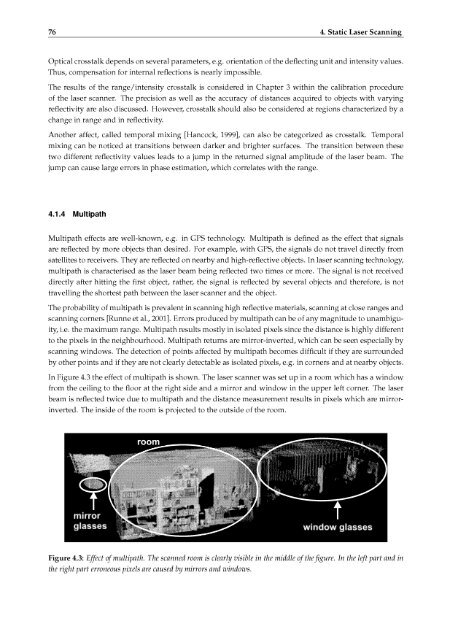Calibration of a Terrestrial Laser Scanner - Institute of Geodesy and ...
Calibration of a Terrestrial Laser Scanner - Institute of Geodesy and ...
Calibration of a Terrestrial Laser Scanner - Institute of Geodesy and ...
You also want an ePaper? Increase the reach of your titles
YUMPU automatically turns print PDFs into web optimized ePapers that Google loves.
76 4. Static <strong>Laser</strong> ScanningOptical crosstalk depends on several parameters, e.g. orientation <strong>of</strong> the deflecting unit <strong>and</strong> intensity values.Thus, compensation for internal reflections is nearly impossible.The results <strong>of</strong> the range/intensity<strong>of</strong> the laser scanner.crosstalk is consideredin Chapter 3 within the calibration procedureThe precision as well as the accuracy <strong>of</strong> distances acquired to objects with varyingreflectivity are also discussed. However, crosstalk should also be considered at regions characterized by achange in range <strong>and</strong> in reflectivity.Another affect, called temporal mixing [Hancock, 1999], can also be categorizedmixing can be noticed at transitions between darker <strong>and</strong> brighter surfaces.two different reflectivity values leads to a jump in the returned signal amplitudejump can cause large errors in phase estimation, which correlates with the range.as crosstalk. TemporalThe transition between these<strong>of</strong> the laser beam. The4.1.4 MultipathMultipath effects are well-known, e.g. in GPS technology. Multipath is defined as the effect that signalsare reflected by more objects than desired. For example, with GPS, the signals do not travel directly fromsatellites to receivers. They are reflected on nearby <strong>and</strong> high-reflective objects. In laser scanning technology,multipath is characterised as the laser beam being reflected two times or more. The signalis not receiveddirectly after hitting the first object, rather, the signal is reflected by several objects <strong>and</strong> therefore, is nottravelling the shortest path between the laser scanner <strong>and</strong> the object.The probability <strong>of</strong> multipath is prevalent in scanning high reflective materials, scanning at close ranges <strong>and</strong>scanning corners [Runne et al., 2001]. Errors produced by multipath can be <strong>of</strong> any magnitude to unambiguity,i.e.the maximum range. Multipath results mostly in isolated pixels since the distance is highly differentto the pixels in the neighbourhood. Multipath returns are mirror-inverted, which can be seen especially byscanning windows. The detection <strong>of</strong> points affected by multipath becomes difficult if theyare surroundedby other points <strong>and</strong> if they are not clearly detectable as isolated pixels, e.g. in corners <strong>and</strong> at nearby objects.In Figure 4.3 the effect <strong>of</strong> multipath is shown. The laser scanner was set upfrom the ceiling to the floor at the right side <strong>and</strong> a mirror <strong>and</strong> window in the upperbeam is reflected twice due to multipath <strong>and</strong> the distance measurement results in pixelswhich are mirrorinverted.The inside <strong>of</strong> the room is projectedto the outside <strong>of</strong> the room.in a room which has a windowleft corner. The laserFigure 4.3: Effect <strong>of</strong> multipath. The scanned room is clearly visible in the middle <strong>of</strong> the figure. In the left partthe right part erroneous pixels are caused bymirrors <strong>and</strong> windows.<strong>and</strong> in












